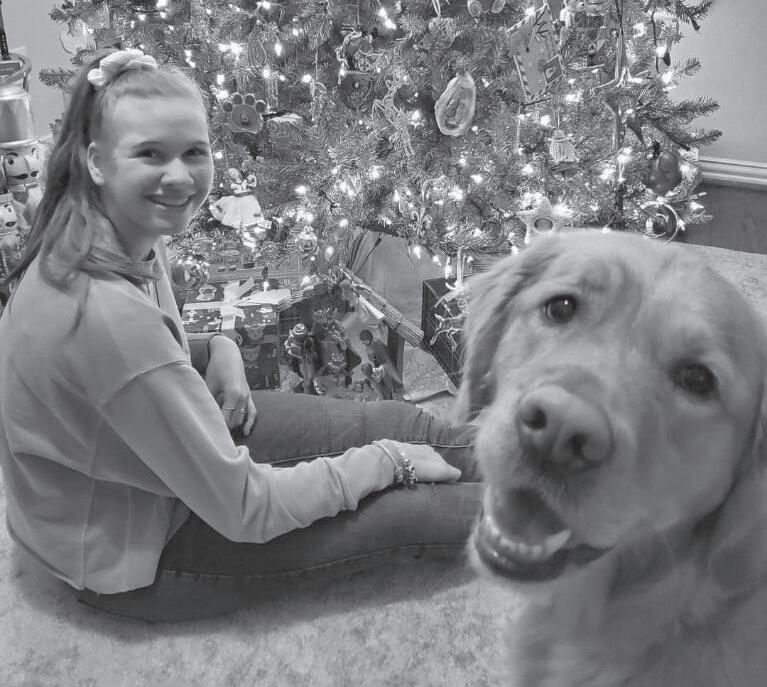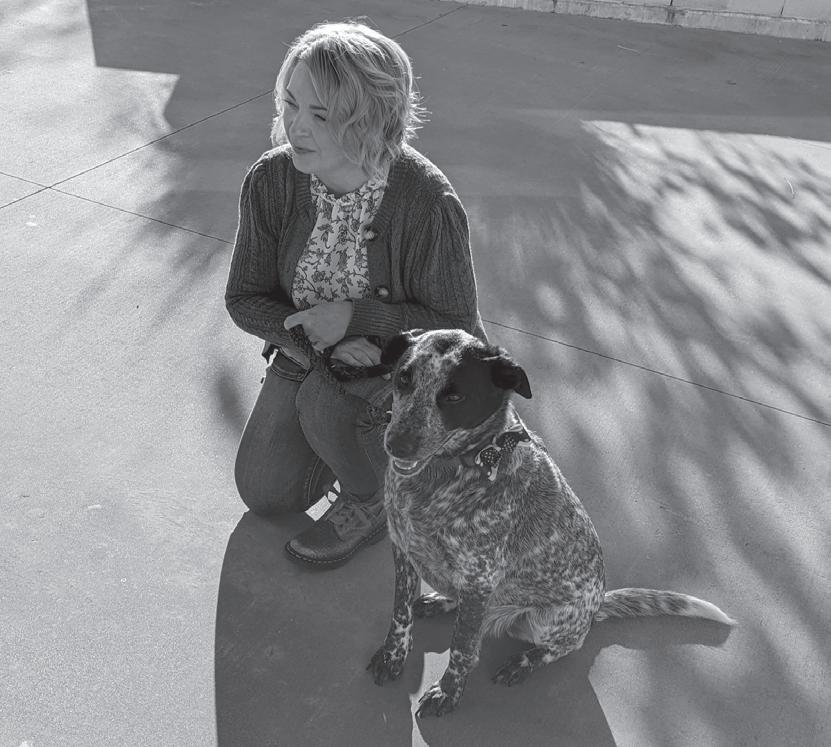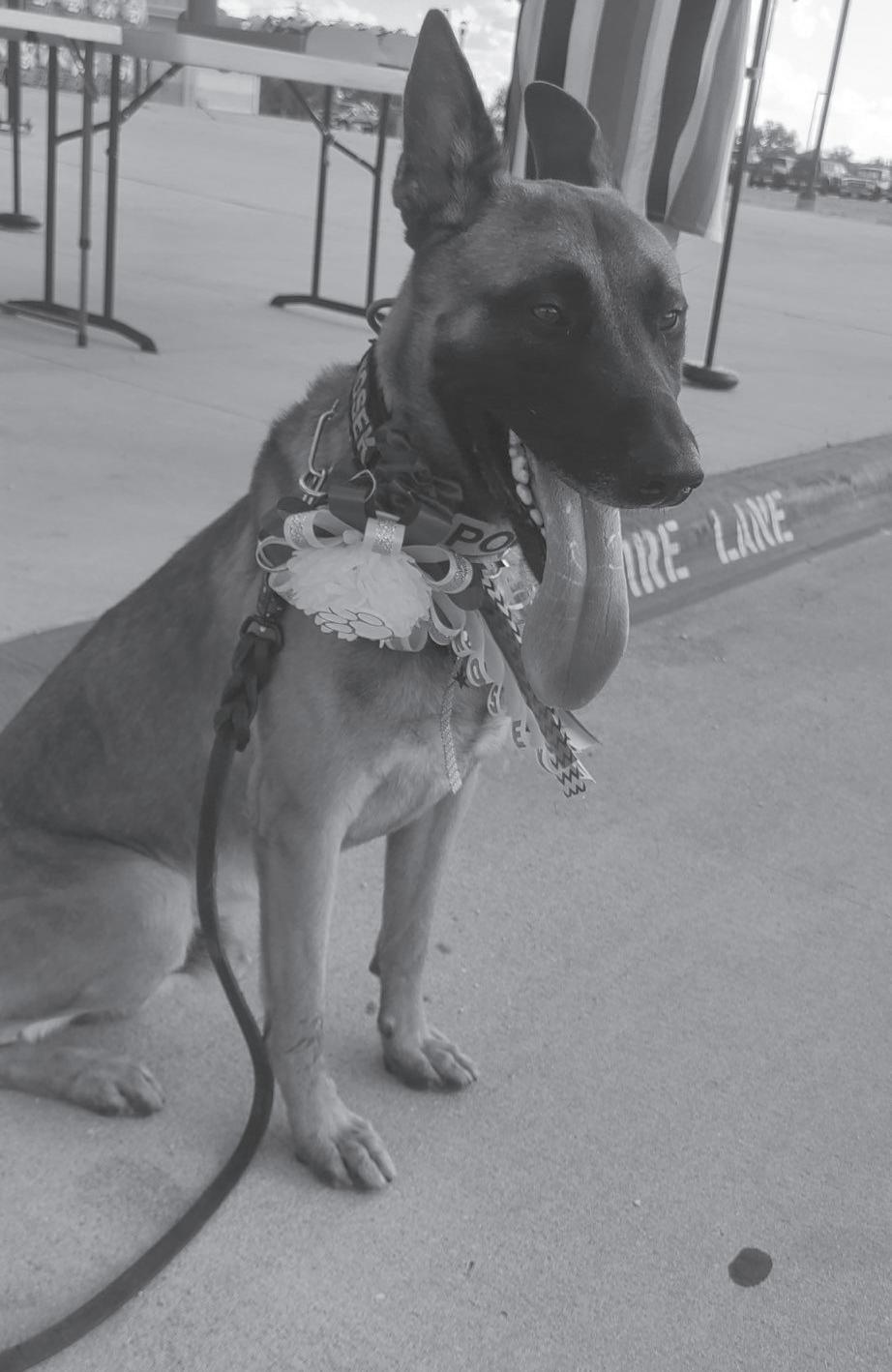
8 minute read
A DOG’S LIFE
Working canines provide variety of services at LHHS
BY SCOTT AKANEWICH
STAFF WRITER
Service dogs have long held a place in their handlers’ hearts, along with those they serve – be it a police K9, a therapy dog or any of the myriad kinds of canines that serve a variety of purposes.
Liberty Hill High School currently has a trio of four-legged servants, with each performing a distinctly different role as the result of specialized training designed to bring about the desired results.
One is a working dog, another specializes in helping provide comfort and yet another guards against medical emergencies – and each one has a story.
On the beat
Anyone who spends any time at all on any of the eight campuses spread across the Liberty Hill Independent School District knows Nosek, the gregarious, playful Belgian Malinois that functions as the K9 for the LHISD Police Department.
Nosek is a working dog trained to detect various kinds of drugs and paraphernalia while patrolling the halls of the high school with his handler and owner, Sgt. Jason Wolf, of the LHISD PD, who said there are two characteristics a working dog needs to be proficient.
“The biggest things are temperament and energy,” said Wolf. “A dog needs to have the right kind of temperament to be able to go through the training process and the energy to go out and work and not get tired. But, most of all, you need a dog that is willing to work.”
Working dogs have an inner mechanism known as a “toy drive” – an instinct that creates a relentless desire to seek out and find particular objects they are fond of.
For Nosek, his favorite is a black rubber grenade he will chase down with an unrelenting pursuit until it’s firmly in his mouth and is focused on nothing more then securing it – the exact trait that enables him to sniff out and find the different kinds of narcotics he’s trained to detect.
School police conducts random checks around the high-school campus, which is when Nosek springs into action doing what he does best – searching and finding, said Wolf.
“For example, if he goes into a room, all the drawers will smell the same to him, except for the one that has one of the drugs he’s trained to detect because his nose is so sensitive,” he said. “When he finds something, he’ll usually just sit down near it.”
However, during his travels around the district, Nosek will often times find himself chasing other various objects, such as foul balls at Panthers baseball and softball games, outracing young spectators that usually track them down.
According to Wolf, one of Nosek’s biggest strengths is his ability to function around all the school-age children he comes into contact with on a daily basis.
“He’s very good around kids,” said Wolf. “I think a lot of them know him better than they know me.”
Interestingly enough, his name suggests his job description, as “Nosek” is Polish for “nose,” – he was born and bred in Poland – although he responds to commands in Czech.
Despite his serious business while on the job, though, Nosek is a playful spirit that always manages to brighten up whatever situation he finds himself in, said Wolf.
“With as goofy and funny as he is, it’s hard to have a bad day when he’s around,” he said. “He’s my sidekick.”
When his work for the day is done, Nosek heads home with Wolf to his 5 1/2-acre home where he has plenty of company, as he is one of 14 dogs Wolf houses in his own private kennel, along with many other animals including horses, goats and donkeys,to name a few.
But, when the sun rises the next morning, it’s back off to work again – for both man and dog.
“You know, that’s one of the best things about my job,” said Wolf. “I get to take my dog to work with me.”
Canine comfort
When a student at Liberty Hill High School finds him or herself in Missy Whitsett’s office, they have been referred because they are struggling with multiple stressors including, but not limited to, academic pressure, family situations, social pressures and anxiety.
Whitsett is the school’s mental health counselor, in charge of corralling teenage emotions gone wild in her calm, soothing surroundings decked out in all manner of unique trinkets and various objects designed to relax the minds of her students.
However, a few brand-new items have been added to her collection, not the least of which is a crate in one corner of the room that serves as shelter for Gus, an Australian Cattle Dog/Brittany Spaniel mix that acts as a therapy dog – a calming companion that can ease the tension that sometimes exists when a student finds him or herself in her office, said Whitsett.
“It really depends on what each student needs in the moment,” she said. “For every person that comes in her, it’s different.”
Currently, Gus is going through the Animal Assisted Counseling Academy program at Texas State University to become a certified therapy dog, but that doesn’t mean he can’t already offer what a troubled student needs – even for just a moment.
“Some people just need a dog to sit on their foot to feel better,” said Whitsett. “For others, it might me to brush or pet him, play a game or teach a skill. Sometimes, it seems like, on some level, Gus knows exactly what his job is.”
Whitsett said she can sometimes use Gus as a gauge for how a student is feeling.
“I’ve learned a lot about dog psychology through my years of training at Texas State and with other professional dog trainers,” she said. “You can learn how to read a dog’s
Liberty Hill High School student Cameron Cousins and Oce, a Golden Retriever/Labrador mix that serves as a medically-tasked service dog due to her cerebral palsy and epilepsy, are an inseparable pair. (Courtesy Photo)
Photo caption goes here lorrores quisi none voluptis id quosanda nim aut fuga. Et pos conse velessusciis dolesto quodit excea cus doloressed qui ab inveribus essitibus evelit la volectio. Itatem quam, aut aborem volum . PHOTO

(Above) Missy Whitsett, Liberty Hill High School’s mental health counselor, will use Gus, an Australian Cattle Dog/Blue Heeler, as a certified therapy dog once his training is complete. PHOTO BY SCOTT AKANEWICH (Right) Nosek, a Belgian Malinois, functions as a K9 for the Liberty Hill ISD Police Department and is trained to detect various drugs. (Courtesy Photo)
body cues and incorporate that into your counseling. For example, he can tell when a student is getting anxious – body position, his eyes, ears or tail will do certain things and it’s my job as a handler to know these things so that I can guide and facilitate a safe, healthy and beneficial interaction for the student and for Gus.”
Of course, it’s been said the way to a dog’s heart is through their stomach and Gus is certainly no exception – in fact, there’s a particular treat he simply can’t get enough of, said Whitsett.
“Gus loves cheese,” she said. “Especially cheddar.”
Sensing the invisible
Cameron Cousins walks the halls of Liberty Hill High School attending classes just like any other student.
But, the junior is differentiated from her classmates by the company she keeps in the form of Oce, a Golden Retriever/Labrador mix – a medically-tasked service dog – that is trained to know when Cousins is about to suffer a seizure, the result of her cerebral palsy and epilepsy.
“When I was born, I had a collapsed lung, so my brain wasn’t getting enough oxygen, which caused a stroke,” said Cousins. “So, that part of my brain is dead, which is what causes my cerebral palsy.”
Amazingly, Oce can sense a chemical change inside Cousins’ body that is the early warning of a seizure and alerts her to be ready before she even realizes what’s happening herself.
Cousins said this skill is the result of intensive training Oce underwent to familiarize himself with her body chemistry.
“When Oce was training, we sent them clothing items and blankets that belonged to me,” she said. “We sent ones from when I was feeling normal and others from when I was having a seizure, so he learned how to tell the difference.”
Cousins’ body gives off an odor undetectable by humans when she is about to suffer a seizure – one Oce can recognize and make her aware of.
“It’s like an early-warning system,” said Cousins. “I can have focal seizures, when I’m conscious of what’s happening and absence seizures, which is when I’ll just stare off into space, then go black and I don’t know what I’m doing.”
Cousins has had Oce at her side since fifth grade after traveling to Ohio to participate in his training, which was where the chemistry between the two was first forged, she said.
“I went there for two weeks,” said Cousins. “I’m actually afraid of dogs, but at one point, we had one of those ‘Lassie’ moments and immediately had a bond – there was a connection and we had a lot of trust.”
Perhaps the primary factor in the cohesion between the pair is the similarity in personality types, she said.
“I’m a very calm person – I kind of like to just go off and do my own thing,” said Cousins. “In class, Oce will just lay down by my desk and sleep.”
Earlier on in her educational experience – before she had Oce – Cousins said she struggled with not fully understanding her condition and the limitations it placed on her.
“I never really fit in and I didn’t know why,” she said. “I got bullied pretty bad, but that all stopped when I got Oce in fifth grade.”
Ever since, the pair is virtually – and in many cases, literally – inseparable.
“Oce never leaves me alone – when I’m at home, I can switch rooms and he’ll always follow me,”said Cousins. “He gives me a lot of comfort and a feeling of protection – I always feel safe.”










